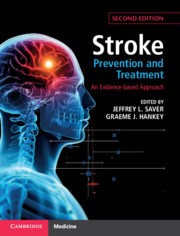Book contents
- Stroke Prevention and Treatment
- Stroke Prevention and Treatment
- Copyright page
- Dedication
- Contents
- Contributors
- Preface
- Part I Foundations
- Part II Systems of Care
- Part III Acute Treatment of Ischaemic Stroke and Transient Ischaemic Attack
- Part IV Acute Treatment of Haemorrhagic Stroke
- Part V Prevention
- Chapter 15 Prevention of Stroke by Lowering Blood Pressure
- Chapter 16 Prevention of Stroke by Lowering Blood Cholesterol Concentrations
- Chapter 17 Prevention of Stroke by Modification of Additional Vascular and Lifestyle Risk Factors
- Chapter 18 Drugs, Devices, and Procedural Therapies to Prevent Recurrent Cardiogenic Embolic Stroke
- Chapter 19 Long-term Antithrombotic Therapy for Large and Small Artery Occlusive Disease
- Chapter 20 Carotid and Vertebral Artery Revascularization
- Chapter 21 Cervical Artery Dissection and Cerebral Vasculitis
- Chapter 22 Prevention of Intracerebral and Subarachnoid Haemorrhage
- Part VI Stroke Rehabilitation and Recovery
- Index
- References
Chapter 19 - Long-term Antithrombotic Therapy for Large and Small Artery Occlusive Disease
from Part V - Prevention
Published online by Cambridge University Press: 15 December 2020
- Stroke Prevention and Treatment
- Stroke Prevention and Treatment
- Copyright page
- Dedication
- Contents
- Contributors
- Preface
- Part I Foundations
- Part II Systems of Care
- Part III Acute Treatment of Ischaemic Stroke and Transient Ischaemic Attack
- Part IV Acute Treatment of Haemorrhagic Stroke
- Part V Prevention
- Chapter 15 Prevention of Stroke by Lowering Blood Pressure
- Chapter 16 Prevention of Stroke by Lowering Blood Cholesterol Concentrations
- Chapter 17 Prevention of Stroke by Modification of Additional Vascular and Lifestyle Risk Factors
- Chapter 18 Drugs, Devices, and Procedural Therapies to Prevent Recurrent Cardiogenic Embolic Stroke
- Chapter 19 Long-term Antithrombotic Therapy for Large and Small Artery Occlusive Disease
- Chapter 20 Carotid and Vertebral Artery Revascularization
- Chapter 21 Cervical Artery Dissection and Cerebral Vasculitis
- Chapter 22 Prevention of Intracerebral and Subarachnoid Haemorrhage
- Part VI Stroke Rehabilitation and Recovery
- Index
- References
Summary
Long-term (>1 year) single antiplatelet therapy with aspirin is effective in reducing the risk of any early recurrent stroke by about one-sixth compared with no antiplatelet therapy. Clopidogrel monotherapy is marginally but significantly more effective than aspirin in reducing major vascular events. Cilostazol is also more effective than aspirin in Asian patients, and its therapeutic efficacy may be augmented by the addition of probucol in patients with ischaemic stroke and high risk of cerebral haemorrhage. The safety and effectiveness of cilostazol in non-Asian patients is not known. Prasugrel monotherapy (3.75 mg daily) is not non-inferior to clopidogrel monotherapy among Japanese patients with non-cardioembolic ischaemic stroke. Dual antiplatelet therapy with aspirin and extended-release dipyridamole is more effective than aspirin monotherapy and equally effective as clopidogrel monotherapy in preventing recurrent stroke. Dual antiplatelet therapy with aspirin and clopidogrel is more effective than aspirin monotherapy in preventing recurrent ischaemic stroke and myocardial infarction in high vascular risk patients, but it also increases the risk of major bleeding which may offset its benefits. Dual antiplatelet therapy with cilostazol added to aspirin or clopidogrel is more effective, and as safe as, aspirin or clopidogrel monotherapy in Japanese patients with non-cardioembolic ischaemic stroke.
Keywords
- Type
- Chapter
- Information
- Stroke Prevention and TreatmentAn Evidence-based Approach, pp. 384 - 411Publisher: Cambridge University PressPrint publication year: 2020



